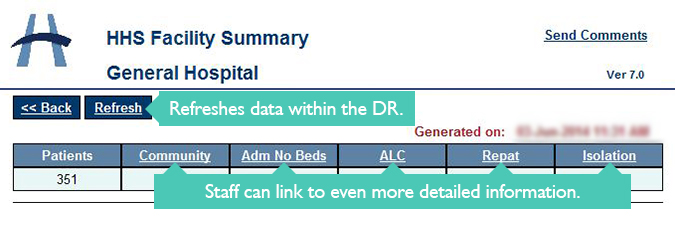July 10, 2015 - Until recently, Hamilton Health Sciences (Hamilton, ON), a 1,100-bed organization consisting of seven specialty hospitals, was no stranger to patient bottlenecks and longer wait times.
Challenged to improve their bed flow, they integrated their MEDITECH Data Repository with the Bed Board—a tool that centralizes bed management activity throughout HHS. As a result, the entire enterprise now has better access to information and can transition patients much more quickly.
“When making decisions about transitioning a patient’s care, data has to be accurate,” says Jackie Crews, HHS manager of production systems and eHealth solutions informatics.
Bottleneck Blues
“We were looking at disparate reports, making it hard to determine things like discharge destination,” says Bill Butler, eHealth solutions informatics technical team lead at HHS. “We needed a process that would enable us to use proactive data."
To fix the problem, HHS enlisted MEDITECH’s help to get a better understanding of the information clinicians relied on to coordinate bed flow — expected length of stay, nursing documentation, and more — as well as the impact of disparate reports.
“Over time we had created too many forms, which clouded the information we needed to see,” explains Butler. “MEDITECH helped us to reorganize our queries and indexes, incorporating into the Bed Board only the data we needed for transition planning — and leaving out the unnecessary items.”
Mastering the Bed Necessities
The ultimate result? A standard bed management report, more efficient care, and a better patient experience. The new report reflects current information and is immediately accessible throughout the organization, helping to streamline bed management meetings and expedite patient care.
“Now, we can easily see the information we need to get patients more quickly to the care settings where they should be recovering.” Crews says. “And that has made all the difference for us.”
Standardizing Yields Enormous Benefits
Thanks to Crews’ and Butler’s efforts, HHS maintains bed flow transparency throughout all of their facilities. Next, they plan to bring in scheduling information so that staff will see what’s booked and be able to plan ahead.
“There are so many applications feeding the DR,” explains Crews. “We’re finding ways to do more with the information, adding even more value for our decision support teams.”
“This is one of the best projects we’ve ever done,” she adds. "We’ve seen first-hand how the right tools can get everyone on the same page, and how standardized processes can yield enormous benefits.”